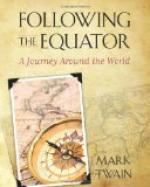The next picture that drifts across the field of my memory is one which is connected with religious things. We were taken by friends to see a Jain temple. It was small, and had many flags or streamers flying from poles standing above its roof; and its little battlements supported a great many small idols or images. Upstairs, inside, a solitary Jain was praying or reciting aloud in the middle of the room. Our presence did not interrupt him, nor even incommode him or modify his fervor. Ten or twelve feet in front of him was the idol, a small figure in a sitting posture. It had the pinkish look of a wax doll, but lacked the doll’s roundness of limb and approximation to correctness of form and justness of proportion. Mr. Gandhi explained every thing to us. He was delegate to the Chicago Fair Congress of Religions. It was lucidly done, in masterly English, but in time it faded from me, and now I have nothing left of that episode but an impression: a dim idea of a religious belief clothed in subtle intellectual forms, lofty and clean, barren of fleshly grossnesses; and with this another dim impression which connects that intellectual system somehow with that crude image, that inadequate idol —how, I do not know. Properly they do not seem to belong together. Apparently the idol symbolized a person who had become a saint or a god through accessions of steadily augmenting holiness acquired through a series of reincarnations and promotions extending over many ages; and was now at last a saint and qualified to vicariously receive worship and transmit it to heaven’s chancellery. Was that it?
And thence we went to Mr. Premchand Roychand’s bungalow, in Lovelane, Byculla, where an Indian prince was to receive a deputation of the Jain community who desired to congratulate him upon a high honor lately conferred upon him by his sovereign, Victoria, Empress of India. She had made him a knight of the order of the Star of India. It would seem that even the grandest Indian prince is glad to add the modest title “Sir” to his ancient native grandeurs, and is willing to do valuable service to win it. He will remit taxes liberally, and will spend money freely upon the betterment of the condition of his subjects, if there is a knighthood to be gotten by it. And he will also do good work and a deal of it to get a gun added to the salute allowed him by the British Government. Every year the Empress distributes knighthoods and adds guns for public services done by native princes. The salute of a small prince is three or four guns; princes of greater consequence have salutes that run higher and higher, gun by gun,—oh, clear away up to eleven; possibly more, but I did not hear of any above eleven-gun princes. I was told that when a four-gun prince gets a gun added, he is pretty troublesome for a while, till the novelty wears off, for he likes the music, and keeps hunting up pretexts to get himself saluted. It may be that supremely grand folk, like the Nyzam of Hyderabad and the Gaikwar of Baroda, have more than eleven guns, but I don’t know.




